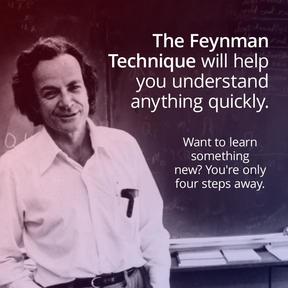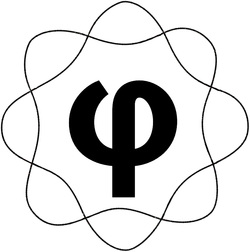
|
Με την τεχνική του Feynman, μαθαίνεις διδάσκοντας ένα θέμα σε κάποιον τρίτο με απλούς όρους, επειδή έτσι εντοπίζεις γρήγορα τα κενά στις γνώσεις σου. Μετά από 4 βήματα, είσαι σε θέση να καταλάβεις το θέμα σε μεγαλύτερο βάθος και να συγκρατείς τις πληροφορίες καλύτερα.
Γιατί είναι σημαντικό Η τεχνική του Feynman είναι ένα νοητικό μοντέλο που επινοήθηκε από τον βραβευμένο με Νόμπελ, φυσικό Richard Feynman. Γνωστός ως «Μεγάλος Επεξηγητής», ο Feynman ήταν σεβαστός για την ικανότητά του να απεικονίζει με σαφήνεια σχεδόν σε όλους, πυκνά θέματα όπως η Κβαντική Φυσική. Στη «Χαμένη διάλεξη του Feynman: Η κίνηση των πλανητών γύρω από τον Ήλιο», o David Goodstein γράφει ότι ο Feynman περηφανευόταν ότι έχει την ικανότητα να εξηγεί τις πιο περίπλοκες ιδέες με τους πιο απλούς όρους. O Goodstein μια φορά ρώτησε τον Feynman «γιατί τα σωματίδια με ημιακέραιο spin υπακούν στην στατιστική Fermi-Dirac». O Feynman απάντησε ότι θα ετοίμαζε μια διάλεξη για αρχάριους σχετική με το θέμα αυτό, αλλά μετά από μερικές μέρες γύρισε με άδεια χέρια. «Δεν μπορούσα να το κατεβάσω σε επίπεδο για αρχάριους» παραδέχτηκε στον Goodstein. «Αυτό σημαίνει ότι στην πραγματικότητα δεν το έχουμε καταλάβει». Δηλαδή, αν ο Feynman δεν μπορούσε να εξηγήσει κάτι με απλούς όρους, υπήρχε πρόβλημα με τις πληροφορίες κι όχι με την διδακτική ικανότητα του Feynman. Γιατί οι άνθρωποι μιλούν σχετικά με αυτήν Η τεχνική του Feynman αναφέρεται με σαφήνεια στην βιογραφία του James Gleick, «Ιδιοφυϊα: η ζωή και η επιστήμη του Richard Feynman». Στο βιβλίο ο Gleick εξηγεί την μέθοδο αναφερόμενος στο πως ο Feynman αρίστευσε στις εξετάσεις του στο Πανεπιστήμιο του Princeton. |
|
Άνοιξε ένα καινούριο σημειωματάριο και στη σελίδα του τίτλου έγραψε: ΣΗΜΕΙΩΜΑΤΑΡΙΟ ΓΙΑ ΤΑ ΠΡΑΓΜΑΤΑ ΠΟΥ ΔΕΝ ΞΕΡΩ. Για πρώτη, αλλά όχι τελευταία φορά, ξαναοργάνωσε τις γνώσεις του. Δούλεψε για εβδομάδες αποσυναρμολογώντας κάθε κλάδο της Φυσικής, «λαδώνοντας» τα κομμάτια και βάζοντας τα πάλι πίσω, αναζητώντας όλο αυτό το διάστημα για ασυνέπειες. Προσπάθησε να βρει ουσιαστικούς πυρήνες για το κάθε θέμα.
|
Ας δούμε τα 4 βήματα:
1. Διάλεξε ένα θέμα που θες να καταλάβεις και άρχισε να το μελετάς. Γράψε σε ένα σημειωματάριο όλα όσα ξέρεις για το θέμα και συμπλήρωνε τη όποτε μαθαίνεις κάτι καινούριο. 2. Προσποιήσου ότι διδάσκεις το θέμα σε τάξη. Βεβαιώσου ότι μπορείς να εξηγήσεις το θέμα με απλούς όρους. 3. Γύρνα πίσω στα βιβλία όποτε κολλάς. Τα κενά στις γνώσεις σου πρέπει να είναι προφανή. Ξαναδιάβασε προβληματικές περιοχές μέχρι να μπορείς να εξηγήσεις όλο το θέμα. 4. Απλοποίησε και χρησιμοποίησε αναλογίες. Επανέλαβε τη διαδικασία, απλοποιώντας τη γλώσσα σου και συνδέοντας τα γεγονότα με αναλογίες για να σε βοηθήσουν να βελτιώσεις την κατανόησή σου. Η τεχνική του Feynman είναι τέλεια για να μάθεις μια καινούρια ιδέα, να καταλάβεις καλύτερα μια υπάρχουσα ιδέα, να ξαναθυμηθείς μια ιδέα ή να μελετήσεις για ένα τεστ. Δεν αστειευόμασταν όταν λέγαμε ότι είναι κατάλληλη για οτιδήποτε. Εσύ πώς θα χρησιμοποιούσες αυτήν την τεχνική; |
|
|
Learn Anything In Four Steps With The Feynman Technique
With the Feynman Technique, you learn by teaching someone else a topic in simple terms so you can quickly pinpoint the holes in your knowledge. After four steps, you're able to understand concepts more deeply and better retain the information. Why It's Important The Feynman Technique is a mental model that was coined by Nobel-prize winning physicist Richard Feynman. Known as the "Great Explainer," Feynman was revered for his ability to clearly illustrate dense topics like quantum physics for virtually anybody. In "Feynman's Lost Lecture: The Motion of Planets Around the Sun," David Goodstein writes that Feynman prided himself on being able to explain the most complex ideas in the simplest terms. Goodstein once asked Feynman to explain why "spin one-half particles obey Fermi-Dirac." Feynman replied that he'd prepare a freshman lecture on it, but then he came back a few days later empty handed. "I couldn't reduce it to freshman level," he admitted to Goodstein. "That means we don't really understand it." That is to say, if Feynman couldn't explain something in simple terms, there was a problem with the information, not with Feynman's teaching ability. Why People Are Talking About It The Feynman Technique is laid out clearly in James Gleick's 1993 biography, "Genius: The Life and Science of Richard Feynman." In the book, Gleick explains the method in terms of how Feynman mastered his exams at Princeton University: "He opened a fresh notebook. On the title page he wrote: NOTEBOOK OF THINGS I DON'T KNOW ABOUT. For the first but not last time he reorganized his knowledge. He worked for weeks at disassembling each branch of physics, oiling the parts, and putting them back together, looking all the while for the raw edges and inconsistencies. He tried to find the essential kernels of each subject." This is the first part of his process, but let's take a look at all four steps: 1. Pick a topic you want to understand and start studying it. Write down everything you know about the topic on a notebook page, and add to that page every time you learn something new about it. 2. Pretend to teach your topic to a classroom. Make sure you're able to explain the topic in simple terms. 3. Go back to the books when you get stuck. The gaps in your knowledge should be obvious. Revisit problem areas until you can explain the topic fully. 4. Simplify and use analogies. Repeat the process while simplifying your language and connecting facts with analogies to help strengthen your understanding. The Feynman Technique is perfect for learning a new idea, understanding an existing idea better, remembering an idea, or studying for a test. We weren't kidding when we said it was good for anything. How would you use this technique? |
|

 RSS Feed
RSS Feed
